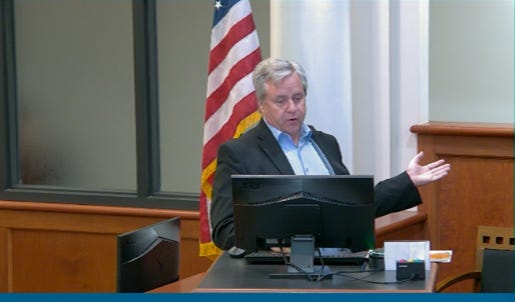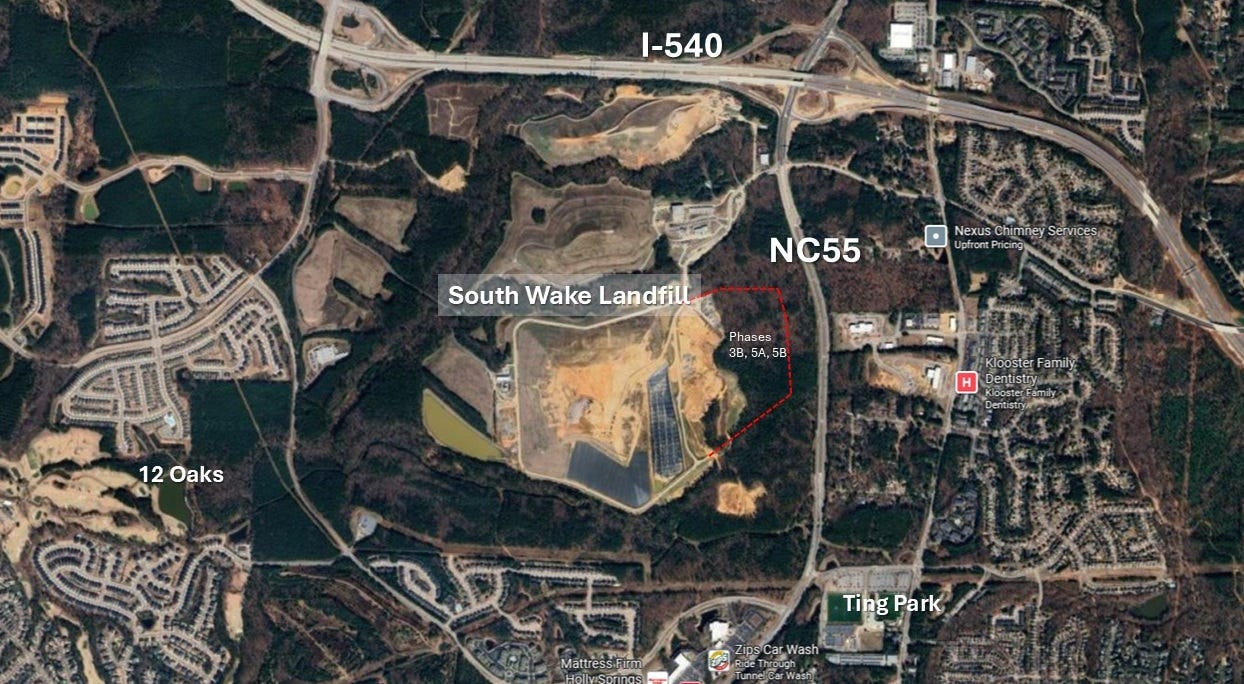County Outlines Landfill Odor Challenges, Improvements, and Long-Range Planning Effort During Holly Springs (NC) Town Council Meeting
Presenters outline causes behind recent odor spikes, detail improvements at the landfill, and the launch of a major planning effort to determine the region’s next waste-management solution.
Holly Springs, NC, Nov. 21, 2025 — During Tuesday’s town council meeting, Wake County solid waste officials delivered a detailed update on the South Wake Landfill’s recent operational challenges, the actions taken to stabilize conditions, and the long-range planning effort now underway to determine the region’s next major waste-management solution.
The presentation was led by John Roberson, Wake County’s Solid Waste Management Director, and supported by Matt Wooster, Operations Manager for GFL Environmental, operator of the landfill.

Together, the two outlined how a combination of environmental, operational, and timing-related factors created difficulties during late summer, but also how targeted investments and early planning for future phases aim to ensure more consistent odor control for residents.
Challenges That Drove Recent Odor Spikes
Although odor levels remain well below the peak years of 2019–2020, Roberson acknowledged that August and September of this year were problematic, driven by a convergence of factors:
Delayed landfill gas (LFG) expansion work, which pushed construction into August, the highest-risk month due to north-to-south wind patterns.
Odor from the reverse osmosis (RO) leachate treatment plant, whose carbon filtration system underperformed until the exhaust was rerouted to the flare station.
Opening of a new disposal phase at the same elevation as nearby neighborhoods, making odor migration easier.
An unusual weather year, with a significantly wet spring followed by a dry, hot summer that increased odor volatility.
Seasonal wind patterns, which predictably carry odors toward Holly Springs in late summer and fall.
Roberson emphasized that these environmental and operational factors overlapped, compounding odor issues for several weeks.
Targeted Improvements and Operational Responses
In response to these challenges, Wake County and GFL Environmental have deployed a series of improvements directly tied to the issues identified:
Landfill Gas Collection Timing: The next LFG expansion will be bid in January and completed before June to avoid summer wind patterns. Roberson stated:
“The goal is to have that project in place and that month and a half, two-month project completed before June.”Reverse Osmosis System Fix: The RO plant’s exhaust is now routed into the landfill’s flare system, eliminating the odor source previously generated during treatment.
Mobile Odor Suppression: A new mobile vapor-based system has been deployed daily at the active work area, replacing a stationary system that lacked flexibility. Two misting systems remain in operation.
Improved Daily Cover: A combination of soil, tarps, and full-site holiday covers is used to seal exposed waste, especially during holiday shutdowns.
New Air Compressor System: A redesigned air supply prevents full-system shutdowns when individual wells malfunction, improving consistency in gas capture.
These steps, county officials said, have already stabilized odor conditions heading into the winter season and will be critical in managing next year’s peak odor months.
Odor Reporting & Metrics: What the Data Shows
Wake County tracks odor through both total odor reports and a refined category called “likely landfill” odors, determined by time of day, sensor data, wind direction, and other criteria. The County’s performance goals are:
Fewer than 100 likely landfill odors per month, and
Fewer than 200 total odor reports per month
The trends shared show:
In 2019–2020, odor reports frequently exceeded 800 complaints per month, the worst in the landfill’s history.
Significant improvements followed operational changes in 2021–2024.
August 2025 exceeded the County’s metric and marked the highest monthly volume of likely landfill odors in two years.
September 2025 also remained above threshold, though improved from August.
October 2025 met the County’s odor metric, and November 2025 was trending under both metrics at the time of the update.
Explaining why August–November consistently pose the highest risk for Holly Springs, Roberson told the council:
“Basically, from August through November, the predominant wind direction is from the north to the south. If you know where the landfill is sitting, most of the communities are south of us.”
This seasonal pattern reinforces the County's aim to complete large construction and gas-collection work before June.
Beyond 2040: Planning for Wake County’s Next Waste Facility
Roberson also outlined progress on the County’s long-range study, “Beyond the South Wake Landfill,” which is evaluating four options to replace landfill capacity when South Wake reaches its projected end of life around 2040:
Building a new landfill (not in Holly Springs)
Developing a regional transfer station and shipping waste to another county
Constructing a waste-to-energy facility
Exploring emerging technologies, such as pyrolysis, gasification, and advanced composting
Stakeholder meetings with regional solid waste groups, municipal managers, and advisory committees are underway. Public engagement is expected in early 2026, with surveys, virtual meetings, and community forums planned.
Prior Holly Springs Update Coverage: Beyond the South Wake Landfill: Wake County Weighs Future as Odor Complaints Continue (September 10, 2025)
A Landfill in Transition
Tuesday’s update underscored the reality that the South Wake Landfill sits at a critical moment. The facility has made significant strides in reducing odors over the past several years, yet seasonal patterns and operational challenges continue to create variability that residents feel and smell.
As Wake County embarks on its long-range planning effort, decisions made over the next several years regarding technology, costs, siting, and environmental impacts will shape the region’s waste system long after the landfill reaches capacity.
For now, the focus remains on stabilizing operations, reducing odor spikes, and preparing for the next phase of Wake County’s waste-management future.


